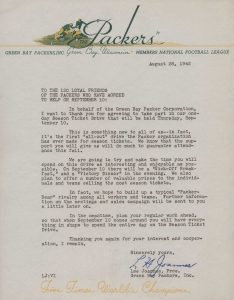24 Memos

Memoranda (memos, for short) are forms of professional correspondence primarily used to communicate with others within an organization. Many formatting conventions of a memo should seem similar to its digital descendant—the email. Like emails, memos are written and distributed to provide updates, publish announcements, and request specific actions.
Why write a memo rather than send an email?
To start with the practical, the fact is that many employees (such as those in industrial and service sectors) don’t have ready access to email. Even those with access may not check email regularly. A memo may be printed out and posted to areas where employees frequent.
Another purpose of the memo is that it serves as a snapshot of a moment in an organization’s history. It may be hard to believe but, in the early days of the Green Bay Packers, volunteers were recruited to sell season tickets. From the 1942 memo from Lee Joannes, we get an idea of what incentives were offered to volunteers as well as the organizational vision for the team and the growing football league. (Courtesy of the Cofrin Library Archives.)
A memo is therefore also a form of archiving for an organization and may contain short-form reports, meeting notes, or summaries of longer reports. Policy memos are a specific sub-genre of memo that communicate changes in organizational structure, protocols, and procedures.
A memo’s audience is almost always known and its distribution is strictly limited to within an organization. Memos may be accessible to the public and should be written as such—no private information should be included. The tone and style of memo writing are both objective and written from a first-person plural perspective.
A CEO, for example, will send memos to employees announcing new products being released. Human resources might post memos announcing new hires or policy changes that impact the workplace. While this information might go out as an email as well, the memo should contain more details and be written in a highly-polished, clear format.
HOW TO WRITE A MEMO
As is found in most forms of professional writing, the memo is a finely-crafted document that prioritizes clarity and concision. Because memos usually contain policy changes and are used for recordkeeping, writing them usually demands several rounds of drafting, reviewing by management, and revising.
Unless sent on behalf of or from top administrators and managers, memos should be written in the first-person plural form (we, our, ours) to suggest inclusion and organizational cohesion.
Keeping in mind that the purpose of memos is to provide clear instruction or information, first consider the fundamental questions that the reader will need answered. According to the School of Public Policy at the The University of Chicago, there are four questions that should be addressed by your memo:
First, describe what is happening. This information should be clearly described in the introductory paragraph. What changes are occurring? What new tools or procedures will be implemented? Which policies are changing and what are those changes?
Because changes are usually implemented to address a problem, you should then describe the ideal state or describe what should be happening. These are the “criteria of success” that measure how an organization is performing.
In most cases (especially if transparency is of value), you will then want to also answer, why is this happening? Describe the motivation for implementing any changes as clearly as possible. Keep in mind that memos can find their way into the public view so private, proprietary information should be avoided. Providing contact information at the end of the memo can help administrators address questions that touch on private matters.
If the change is significant, memos should also indicate what operations, policies, or procedures are currently working.
Finally, be sure to address the important question, what’s next?
Review the Anatomy of a Memo handout for additional guidance.

